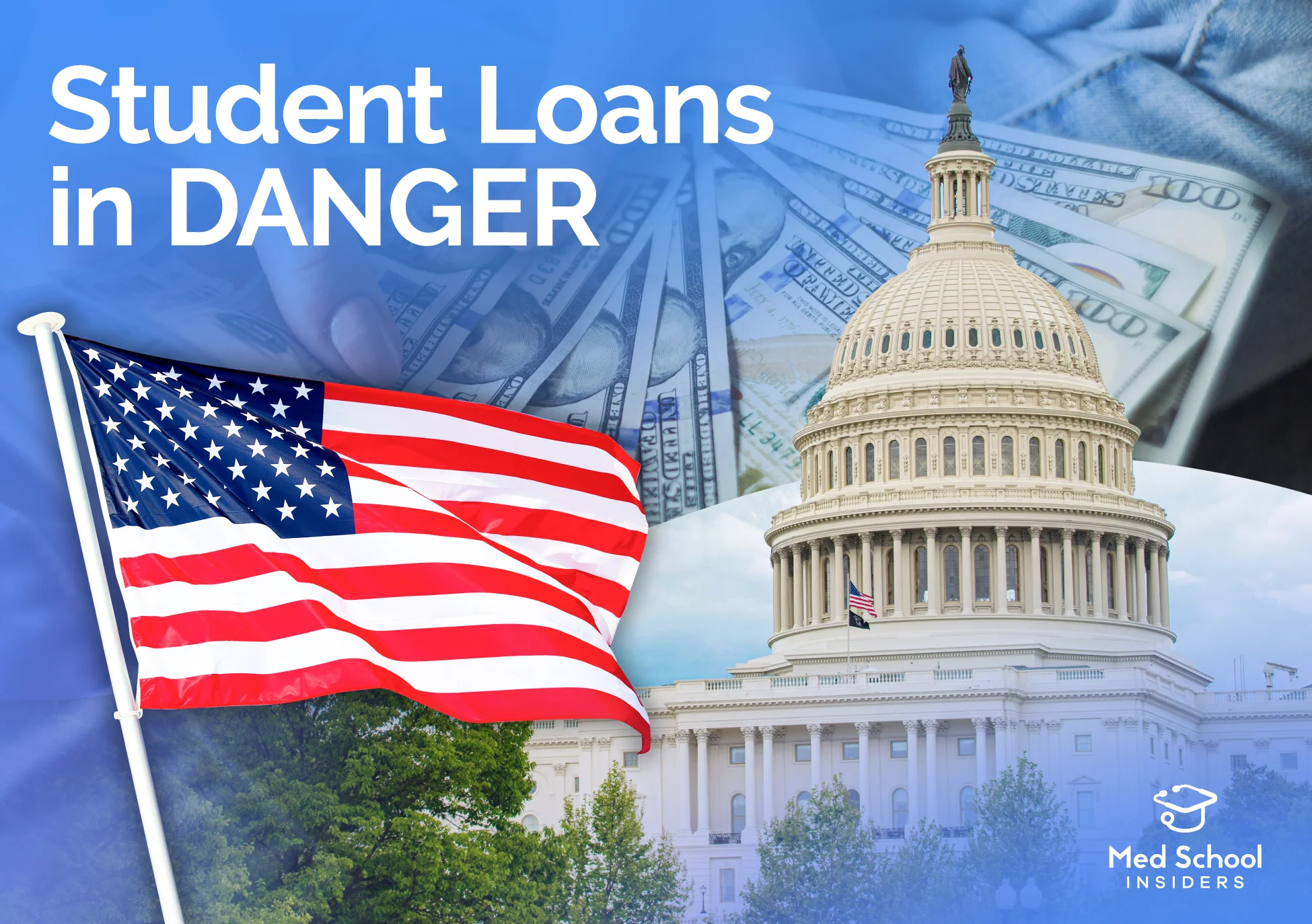
Signs You Can Handle Emergency Medicine
Are you built for the Emergency Department? We reveal the 6 signs that prove you’re destined to succeed in emergency medicine.

A new government bill could destroy your medical school dreams.
Despite the name, the ‘One Big Beautiful Bill Act’ is not so beautiful for students. What’s become a hugely controversial piece of legislation could slash student loan availability, making it even harder to become a doctor.
It passed the House by a narrow margin. And if it passes the Senate, it would fundamentally change how you pay for college and med school, and make residency an even more challenging experience than it already is.
This raises the question: Are we building a system that selects the best and brightest or simply the wealthiest? Stick around until the end when I discuss the long-term impact this will have on the future of our country.
What’s exactly in The One Big Beautiful Bill? It’s being marketed as a way to save the federal government about $350 billion over the next ten years. Sounds great on paper. But where do those savings actually come from?
This legislation proposes cuts to virtually every major federal student aid program.
Graduate loans. Residency support. Even Pell Grants.
And the changes don’t just affect future borrowers; they reshape repayment, forgiveness, and even how much debt you can take on in the first place.
Let’s get into it.
First off, they’re eliminating Subsidized Federal Direct Stafford Loans.
That means if you’re an undergrad student from a lower-income background, you’ll no longer get interest-free support while you’re in school, during your grace period, or if you defer.
I actually received these loans myself, both in college and in medical school. Without them, it would have been much more difficult to become a doctor.
Knowing the interest wasn’t piling up while I was buried in coursework gave me breathing room to focus on learning instead of stressing about the mounting debt.
If this change goes through, the interest-free window is gone. You’ll start accruing interest the day your loan is disbursed.
For most students, this change alone will bump their total debt burden by about 15% by graduation.
That’s thousands of dollars in extra interest, just because the government decided to pull the plug. And it gets worse.
Second, the bill proposes eliminating Grad PLUS.
For med students, this one’s huge: Grad PLUS Loans would be eliminated for any new borrower starting in the 2026-2027 academic year.
If you’re not familiar, Grad PLUS is what lets students borrow up to the full cost of attendance for graduate and professional school, including living expenses.
Without it, you’re capped.
And that cap is now significantly lower. We’ll get to that in a second.
Third, Parent PLUS loans.
Currently, there’s no aggregate limit on Parent PLUS loans.
But under the new bill, starting July 2026, parent borrowers will face new caps: a $20,000 annual limit per child and a $65,000 lifetime limit per child.
So if your parents are trying to cover multiple years or multiple kids, these limits are going to come into play quickly.
There’s no income-driven repayment, no forgiveness options, and no real protections if something unexpected happens. Just rigid contracts and compounding interest.
This pushes families, particularly those without generational wealth, toward private lending, which is a much riskier path with major long-term financial consequences.
Private lending is a terrible, terrible option. I really can’t stress that enough. There’s no deferment, no federal protections, far higher interest rates, and worse terms. Do whatever you can to avoid private loans in the US.
And this next one’s brutal: across the board, the bill imposes hard caps on federal student loans.
Now, let’s put that in perspective.
The average med student graduates with over $260,000 in student loan debt.
If this passes, you’re looking at a $110,000 gap. Where is that extra $110,000 going to come from? While this may be okay for some families, many families don’t have that kind of money lying around.
But things are much worse than that for some students because $260,000 is only the average debt. Some students can have upwards of $400,000 in medical school debt. Meaning there’s another $250,000 to cover with other, much riskier loans.
And keep in mind that we’re looking at medical school debt as it stands in 2025. The average debt continues to increase with rising tuition costs, so if the cap remains set at $150,000, the difference that medical students are left to cover will continue to rise year after year.
If you don’t have rich parents or massive savings, that’s a serious roadblock.
Next, starting in July 2026, all new borrowers will have just two repayment options:
RAP replaces most current income-driven repayment plans, like SAVE or PAYE.
On the surface, it sounds decent: payments range from 1% to 10% of your income, with a minimum of $10 a month.
But loan forgiveness under RAP only kicks in after 30 years of payments.
That’s up from the 20 to 25-year windows we have now.
And those payments?
For many borrowers, they’ll actually be higher than under the SAVE plan, by about $3,000 a year on average.
So yes, it’s simpler. But it’s also more expensive, especially in the long run.
And they’re also cutting back the safety nets.
Economic hardship and unemployment deferments will no longer be available for loans issued after 2025.
And forbearance will be capped at 9 months per 2-year period.
You do get the ability to rehabilitate a defaulted loan twice instead of once, but that’s cold comfort for people just trying to keep their head above water.
And this next point hits med students again.
The bill says that any payments made during residency won’t count toward Public Service Loan Forgiveness, or PSLF.
Since residency can last anywhere from 3 to 7 years, this is particularly devastating, as that’s a huge chunk of your early career.
And if you’re working in public service—especially in underserved areas—you were probably counting on those years to count toward your 10-year forgiveness plan.
This bill wipes that out.
The bill also ties the hands of the Department of Education, preventing future administrations from issuing new regulations that increase loan forgiveness or expand protections for borrowers.
So any future “fixes” to the system will be much harder to pull off.
Next, even Pell Grants aren’t safe.
To qualify for the full award, students would now need to complete 15 credits per semester or 30 per year.
That makes it way harder for part-time or working students to qualify.
And a change to how eligibility is calculated could disqualify over 60% of current recipients, according to the SBPC.
The only expansion is that Pell Grants would now apply to short-term workforce training programs, even those offered by unaccredited providers.
That raises big concerns about abuse, predatory programs, and whether students will actually get value out of those certificates.
Finally, the bill includes a new “risk-sharing” model where colleges are on the hook for a portion of unpaid student debt.
On paper, that might incentivize schools to keep costs in check.
But it’s more likely to result in fewer admissions for high-risk students or reductions in support services.
So, what does all of this actually mean for you?
If you’re a student right now—or planning to become one—this bill makes college and grad school significantly more expensive.
You’re going to:
And if you’re a future doctor**,** this hits even harder.
The average cost of med school tuition alone is already absurd.
Add living expenses, exam fees, residency relocation, and lost income during training. It’s no wonder most med students lean heavily on Grad PLUS.
Take that away, and suddenly studying medicine becomes a luxury only the wealthy can afford.
The $150,000 cap doesn’t come close to covering what you’ll need. Plus, the loss of PSLF during residency removes a major incentive for anyone thinking of going into public service.
And the limited repayment options could leave you with mountains of debt and limited relief.
And here’s where it goes beyond just your personal finances.
We’re already facing a massive physician shortage in the US—nearly 190,000 doctors short by 2037.
Making medical education less accessible could exacerbate this trend, discouraging qualified students from entering the field, particularly those who lack financial backing.
If this bill passes, we’re not just limiting access to education; we’re redefining who gets to become a doctor in the US.
Not based on talent. Not based on grit. But based on who can afford it.
When you limit access to education—whether it’s medicine, law, engineering, or science—you’re not selecting for the most capable.
You’re selecting for the most privileged.
And that has serious long-term consequences for our healthcare system and the country as a whole.
If the US wants to continue being the most powerful and innovative country in the world, we must give gifted, hardworking people every opportunity to succeed, rather than leaving these opportunities only to those who have the most resources due to their family situation.
This isn’t just a student debt issue. It’s a national strategy issue.
And fewer doctors today can become a serious shortage tomorrow.

Are you built for the Emergency Department? We reveal the 6 signs that prove you’re destined to succeed in emergency medicine.

If you have a low GPA and want to be a doctor, all hope is not lost. Here’s how you can get accepted to medical school with a low GPA.